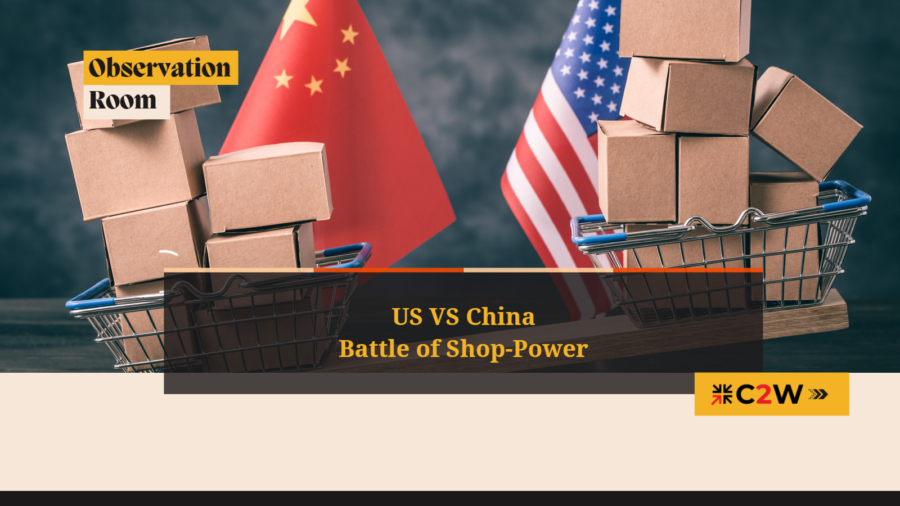This year, the two biggest shopping frenzies happened with only two weeks in between. Singles Day, aka Double 11, a former cynical celebration turned a nationwide cyber shopping fiesta in China, occurred on November 11; Black Friday, just the day after Thanksgiving every year, is already part of the American holiday culture. In this day and age, everything can be turned into a battlefield between the two superpowers. How much people can splash out not only indicates the level of economic recovery from COVID, but also a way of testing the two schools of pandemic control, Living with COVID vs Zero Tolerance.
Now that the numbers are in, what’s the takeaway?

At Least People Spent More Than Last Year
This holiday season has obviously been doing much better than last year, for both countries. Just this past Black Friday a sales increase of 29.8% was reported in the US by Mastercard,[i] which was higher than the forecast of 20% growth.
China, on the other side, had most of its shopping sprees online on 11/11 for its cyber root. Alibaba saw an over 8% jump from last year, while JD welcomed a 28% year-on-year growth.[ii] But the growth was expected in China as their economy has rebounded for a while. The uncertain factor was the western world, despite the mostly optimistic forecasts. Fortunately, it did not disappoint. Since the world is reopening regardless and learns to co-exist with the virus, the general public are having their wallets ready.
It’s A Different Picture for Online Shopping
Store shopping made a decent comeback in the US. Reduced COVID caseloads and never-ending wait time for shipping prompted a 48% increase of store traffic.[iii] People preferred to actually hit the floors of brick-and-mortar stores to get what they needed in time for the holiday. That is to say, the big win of online shopping last year didn’t last. Consumers spent $8.9 billion online on Black Friday, slightly down from the record of $9 billion last year;[iv] this Cyber Monday retailers rang up $10.7 billion, which was a 1.4% decrease from year-ago levels.[v]
Meanwhile, China posted record online sales, totaling $139 billion for Alibaba and JD.[vi] The record sales came as nothing surprising due to the long history of e-commerce. But the noteworthy part here is the growth. Alibaba reported a 26% increase last year, but it dropped to 8.5% for 2021; JD did a little better this year with a 28.6% growth over 33% for 2020. It is believed that Beijing’s crackdown on tech titans has contributed to the slowdown, as all e-commerce platforms have toned down on this year’s shopping extravaganza. The slower economic growth and inflation are considered the reasons too.[vii]
Changes of shopping patterns have also raised red flags for these platforms. Live-stream shopping and group buying have proved to be strong over the years.[viii] Top-notch players of live-stream sales even take away large portions of the cake, to a point where they have garnered some watchful scrutiny from the public and regulators.[ix]

Shopping Got Longer, But Not Cheaper
This holiday shopping season started way earlier than ever.
Since last year, the Singles Day sales have moved up to early October in China, and it’s not just one round of deals from most merchandisers, but several throughout the duration. On top of that, complicated discount algorithms have made shopping a math marathon. These all have fed into consumers’ fatigue, which was to blame for the slow growth this year.[x]
But it’s also more than fatigue. Many merchandisers raised the item prices before going on sale. This practice has not only resulted in public aversion, but also alerted the government.[xi]
In the US, global supply chain disruption has forced many retailers to spread out their deals. Discounts started as early as October as well. In order to avoid lagging behind on shipping, consumers decided to step up and shop early this year, which explains the retail sales growth projection between 8.5%-10.5% for the whole holiday month.
However, consumers didn’t necessarily find holiday shopping as pleasant as it used to be. The deals weren’t considered as good due to inflation and clogged supply chains.[xii] It also led to the relatively poor performance of e-commerce for the holiday long weekend. On Thanksgiving day alone, the sales hit a new low with $5 billion. This marked the first time a drop in big holiday sales was reported by Adobe since 2012.[xiii]
Americans Shop for Fun, While Chinese Shop for A Lifestyle
Black Friday is considered part of holiday shopping for a reason, as many Americans seemingly preferred to spend on electronic products. The hotlist for the holiday weekend and Cyber Monday included Switch, AirPods, video games, tech-toys and VI. Of course, you wouldn’t miss kids’ favorite, Barbie, for sure. As you can see, it’s all about fun.v
Unlike Americans, the Chinese seemed to shop for a lifestyle that they aspire to, more importantly, with a better deal. Luxury goods and pet-related products were popular.ii

National pride has boosted consumption on Made-in-China brands as well. The concept of “guochao”, literally translated as “national trends”, was conceived a few years ago to promote Chinese design to young generations. In light of the current geopolitics, nationalistic sentiment has also more or less fueled this enthusiasm. Adidas recorded a sale of over $200 million on Tmall, a e-commerce platform by Alibaba, whereas the sale of its Chinese equivalent, Anta, exceeded $500 million there.[xiv]
We are still not sure where the world is heading. This newly discovered variant, Omicron, has made it even more unpredictable than ever.
But these numbers indicate at least one thing. As long as we live, we shop. The global supply chain crisis is not going to be over anytime soon. If you are looking to make a safer bet, the only metric we can adopt is history.
Given the track record of pandemic control, China manufacturing still seems more reliable.
Feel free to reach out to us.
[i] https://www.cnn.com/2021/11/26/business/holiday-shopping-retail-friday/index.html
[ii] https://www.cnbc.com/2021/11/12/china-singles-day-2021-alibaba-jd-hit-record-139-billion-of-sales.html
[iii] https://www.businessinsider.com/black-friday-2021-sales-stats-performance-online-in-store-2021-11
[iv] https://www.cnbc.com/2021/11/27/black-friday-shopping-in-stores-drops-28percent-from-pre-pandemic-levels.html
[v] https://business.adobe.com/resources/holiday-shopping-report.html
[vi] https://www.cnbc.com/2021/11/12/china-singles-day-2021-alibaba-jd-hit-record-139-billion-of-sales.html
[vii] https://www.cnn.com/2021/11/10/business/china-singles-day-intl-hnk/index.html
[viii] http://finance.sina.com.cn/tech/csj/2021-11-12/doc-iktzscyy5018631.shtml
[ix] https://news.sina.com.cn/s/2021-11-22/doc-iktzscyy7096803.shtml
[x] http://m.caijing.com.cn/api/show?contentid=4816957
[xi] https://finance.sina.com.cn/china/gncj/2021-11-12/doc-iktzqtyu6832743.shtml
[xii] https://www.latimes.com/business/story/2021-11-26/black-friday-2021-pandemic-shoppers-descend-on-retail-outlets-malls-shopping-for-deals
[xiii] https://www.nytimes.com/2021/11/29/business/black-friday-sales.html
[xiv] https://www.sohu.com/a/503174101_498715


